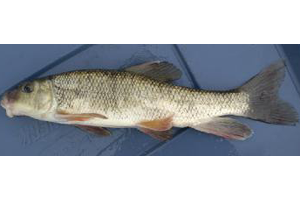Although generally not a popular fish among fisheries workers or anglers, this native species is abundant in most of its range and is one of the most ecologically important fish species in many streams and lakes.
Photo Credit: Brian Coad
Catostomus commersonii
Common Name: white sucker
Animal Guild: Fish
Class > Order > Family: Teleostei > Cypriniformes > Catostomidae
What does the species look like?
The bodies of white suckers are almost cylindrical. Their rounded snout barely projects beyond their upper lip when viewed from below. They have a large, horizontal mouth and thick lips (the lower lip is about twice as thick as the upper lip). Their lower lip has a deep notch in the middle. They have 0 to 3 rows of papillae (nipple-like bumps) in the middle of their lower lip, and two to six rows on their upper lip. They have fewer than 75 scales in a lateral series. They have a brownish to blackish back.
Breeding males: Often have a gold back and a scarlet stripe on each side.
Juveniles: Often have three or more dark blotches on their sides (as do some adults).
White suckers can reach a total length of up to 25.2 inches (64 cm).
Where is the species found?
States & Provinces
AB, AL, AR, BC, CO, CT, DC, DE, GA, IA, IL, IN, KS, KY, MA, MB, MD, ME, MI, MN, MO, MT, NB, NC, ND, NE, NH, NJ, NL, NM, NS, NT, NY, OH, OK, ON, PA, QC, RI, SC, SD, SK, TN, UT, VA, VT, WI, WV, WY, YT
Distribution
The native range includes the Atlantic, Arctic, Great Lakes, and Mississippi River basins from Labrador to the Mackenzie River, and south to the Tennessee River drainage, northern Alabama, and the Arkansas River drainage, New Mexico. White suckers occur south on the Atlantic Slope to the Santee River drainage, South Carolina; in the upper Rio Grande drainage, New Mexico; and in the Skeena and Fraser river drainages (Pacific Slope), British Columbia. The species has been introduced in several drainages in Wyoming, Colorado, Utah, Georgia, and probably North Carolina. It occurs in a wide variety of lake and stream habitats. Some migrate dozens of miles or kilometers between the lakes or streams where they spend much of their lives and their spawning areas. They often spawn in swift water or rapids in small, clear, cool creeks and small to medium rivers, usually in water less than 12 inches (30 cm) deep. They sometimes spawn on lake shoals, beaches, or rivermouths (areas with wave action).
General Phenology and Life History
White suckers usually spawn in spring or early summer. The eggs sink and usually stick to, and become lodged in, gravel. They hatch 5 to 15 days after being laid, depending on the temperature. Adults may reside temporarily in spawning streams before returning to a lake or larger stream. Mature white suckers may not spawn every year.
Which phenophases should I observe?
Do you see/hear...?
Activity
Adults in freshwater More...
For abundance, enter the number of individual animals observed in this phenophase.
Adults feeding For abundance, enter the number of individual animals observed in this phenophase.
Adults migrating downstream More...
For abundance, enter the number of individual animals observed in this phenophase.
Development
Dead or dying adults For abundance, enter the number of individual animals observed in this phenophase.
Method
Individuals on a hook For abundance, enter the number of individual animals observed in this phenophase.
Individuals in a net For abundance, enter the number of individual animals observed in this phenophase.
What do these phenophases look like?
There is currently no photoguide available for this species. If you'd like help us create one, use the guidance document and species template provided here . Then send it via email to education@usanpn.org when it is complete.
